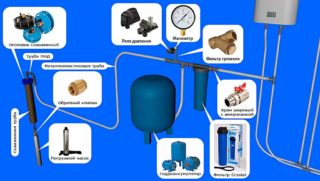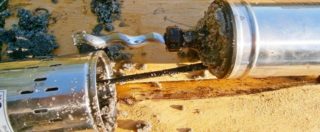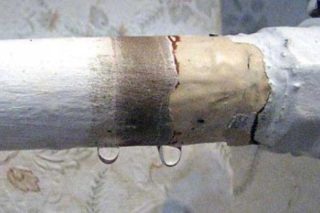The main working part of an autonomous water supply system is a pumping station. It includes units that maintain constant pressure in the pipeline. There can be many reasons for technical malfunctions. The most common problem is that the pump in the well does not automatically turn off. It is difficult to find an unambiguous solution, since several factors affect the rhythm of work at once.
The main malfunctions in the operation of the borehole pump and how to fix them

Most models of borehole pumps, as a rule, are designed for a limited number of starts per unit of time. In the passport attached to the equipment, the manufacturer indicates the permissible number of shutdowns / starts per hour. The water pump in the well is often turned on if the number of starts varies within 15-30.
If the pump stops working properly, its performance has decreased, you must immediately take all measures to eliminate the problem. Otherwise, the unit will overheat and burn out or the breakdown will become more significant.
Pressure regulator malfunctions
If the downhole pump turns off and on very often, one of the reasons is the improper operation of the pressure regulator. To make sure it works, a number of sequential actions are performed.
First of all, they check the readings of the built-in pressure gauge, if it is included in the package of the pumping well station. The manipulation can be carried out using a car pump with a built-in pressure gauge.
The control unit is checked according to the following algorithm:
- remove the protective cover from the pump;
- pump air into the accumulator cylinder through the safety valve, creating a working pressure in it at the minimum permissible level;
- by turning the rotary screw counterclockwise, reduce the pressure threshold, upon reaching which the unit should automatically turn on;
- bleed air and pump it up again, repeat the manipulation several times.
The submersible pump relay should automatically operate when the minimum pressure is reached. They are indicated in the accompanying documentation, usually this manual or operating instructions.
The submersible pump may stop working due to the exceeded maximum permissible threshold on the relay. The optimum level is 95% of the maximum allowable pressure in the water supply system.
If the water from the well comes in jerks, and then stops altogether, check the condition of the equipment inlet. It may be clogged with sand, silt, mud, and small algae. To eliminate the problem, it is enough to remove the dirt with a stiff brush.
Interruptions in the operation of the injection pump

In a private home, the water supply system will often turn on if there is a power outage. If the equipment is not supplied with electricity at the correct level, the impeller will not be able to deliver the required power. Under such operating conditions, the pump will not be able to create the maximum head in the pipeline, therefore it will work without interruption.
Lack of power is also the result of malfunctioning of individual components of the pump, for example mechanical or electrical.
The main reasons for the power shortage:
- Clogged inlet and outlet pipes. To fix the problem, you need to rinse and clean the parts with detergent solutions and brushes with abrasive particles.
- Oxidation of the terminal box surfaces: clean them with fine emery paper. It is important to disconnect the electrical appliance from the power source beforehand.
- Unstable voltage. Vibrations should be checked with the pumping station running. There is only one way to fix the problem - to additionally install a voltage regulator.
During operation, the mechanical parts of the device inevitably wear out, which negatively affects the power and performance of the equipment. You can check the performance of the pump by carefully examining it after disconnecting it from the outlet water supply.
A weak head indicates a strong wear of the parts. Most of them cannot be repaired, so the working units often have to be replaced entirely.
Pressure accumulator problems
A common reason for frequent switching on of the pump is a malfunction in the accumulator. If the integrity of the tank is compromised, this will inevitably lead to a drop in the operating pressure in the pipeline.
If the damage is significant, you will most likely need to completely replace the battery.
Other reasons

If the checks have shown that the parts are in good order, it is time to start revising the pipeline.
The pump often starts up for the following reasons:
- Depressurized sections or holes in the pipes have formed in the pipeline. The loss of pressure in the water supply system inevitably leads to the presence of leaks.
- The supply pipe is clogged with sand, silt, fine algae and other solid particles. This leads to a decrease in capacity and a decrease in head. If measures are not taken in a timely manner, water will stop flowing into the house, and the components of the equipment will overheat.
- The water level in the well dropped and the filling process slowed down.
The search for damaged places in the pipeline located in hidden areas is carried out by a step-by-step check of individual parts of the water supply network. The pressure in each must be measured using a pressure gauge.
The checked area can be considered suitable for further operation if, in the absence of water intake, the indicators on the manometer do not change within half an hour.
Contamination, foreign matter entering the check valve can also lead to frequent starts of the pump. To fix the problem, you need to disassemble the unit and remove the excess; at the end, be sure to thoroughly rinse the water fittings. It is possible that the check valve is worn out and requires replacement, since it has lost its tightness.
Preventive measures
To prevent or minimize the likelihood of serious breakdowns of downhole equipment, it is necessary to carry out high-quality preventive maintenance at intervals of a year. This will allow timely identification of malfunctions in the operation of the nodes. The ideal time for manipulation is spring and autumn.
- Carefully remove the submersible pump from the wet environment. On the surface, carefully examine the case for minor faults / scuffs, as well as examine the condition of the electrical cable and the suspended safety cable. Failure to pay attention to worn parts in a timely manner may result in equipment breakage or burnout due to a faulty electrical cable.
- Examine the pump for deformation, dirt, or corrosion. The components must be thoroughly cleaned and rinsed with plenty of clean water.
If a large amount of silt or sand accumulates on the surface of the body, this indicates that the well is sandy. Therefore, it needs flushing.Having lowered the pump into a container with clean water, it must be turned on and checked for extraneous noise. If any are observed, one of the nodes is malfunctioning.
Downhole pump problems are not uncommon. This is due, as a rule, to non-observance of the rules of operation and maintenance. You need to take care of the operation of the pumping station at the stage of purchase. It is important to choose the right model with the optimal power, since a high-power model will run "idle", wearing out the parts, and a low-power model, due to technical limitations, will not be able to satisfy the customer's need. Employees of housing and communal services or Vodokanal will be able to help in this matter.








